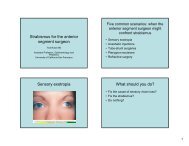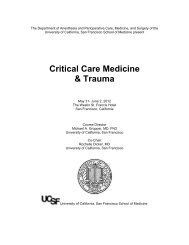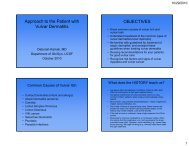Management of Skin and Soft Tissue Infections in
Management of Skin and Soft Tissue Infections in
Management of Skin and Soft Tissue Infections in
Create successful ePaper yourself
Turn your PDF publications into a flip-book with our unique Google optimized e-Paper software.
Classic impetigo<br />
Ecythema<br />
Impetigo<br />
Case 3<br />
Bullous impetigo<br />
• Patient presents with 4 th abscess <strong>in</strong> 4 months<br />
• Prior abscesses have been treated with I&D<br />
<strong>and</strong> antibiotics with resolution<br />
• He asks if there is anyth<strong>in</strong>g he can do to<br />
prevent recurrences<br />
Impetigo<br />
• Def<strong>in</strong>ition: superficial, <strong>in</strong>tra-epidermal <strong>in</strong>fection<br />
• Epi: Common <strong>in</strong> children, highly communicable<br />
• Pathogens: S. aureus, Group A strep<br />
• Treatment:<br />
– Few lesions (topical = systemic)<br />
• Mupiroc<strong>in</strong> or Retapamul<strong>in</strong> o<strong>in</strong>tment<br />
– Multiple lesions (systemic >> topical)<br />
• Pick agent(s) active aga<strong>in</strong>st CA-MRSA <strong>and</strong> Group A strep<br />
How would you manage this<br />
patient?<br />
A. Emphasize personal hygiene<br />
measures<br />
B. Decolonize with mupiroc<strong>in</strong> <strong>and</strong><br />
chlorhexid<strong>in</strong>e<br />
C. Decolonize with TMP-SMX <strong>and</strong><br />
rifamp<strong>in</strong><br />
D. All the above<br />
9%<br />
65%<br />
11%<br />
15%<br />
A. B. C. D.<br />
4/12/2011<br />
5
















